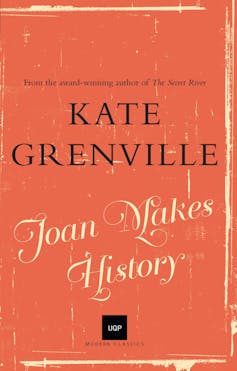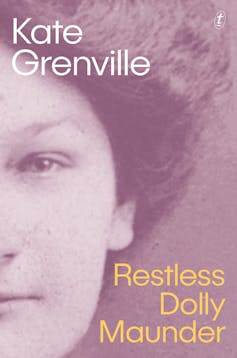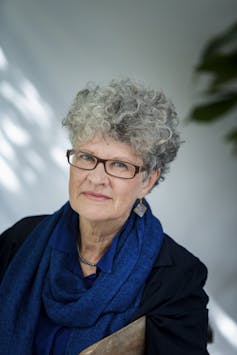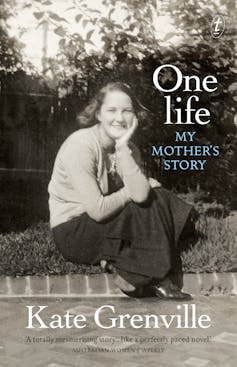Dolly Maunder, born in 1881, is the sixth of seven children of a sheep-farming family outside Tamworth in northern New South Wales. Their lives are a relentless round of hard work, indoors and out, relieved only a by few brief years at the local one-teacher school.
Dolly thrives there – “you’re a quick study”, approves the teacher. She also takes note of Miss Murray, the teacher’s daughter, who runs her own school in a nearby village: “the only woman Dolly knew who wasn’t just at home all day, banging the stove door open and closed, heaving the wet sheets around on washday, milking the cow, and always a baby wailing from the crib in the corner”.
Dolly determines that she will escape the farm, become a teacher, and earn her own way. But her father has different ideas. “Over my dead body!” is his response when she asks his permission to sit the necessary exam: “no daughter of mine goes out to work.”
So Dolly must resign herself to years of labouring in the kitchen, the wash house and the dairy with her mother and sisters, while checking out the local talent with a view to the inevitable marriage, “those iron rails”.
But the men in whom she is interested have their own commitments, and Dolly’s desires are thwarted by barriers of class and religion. She must make do and marry Bert Russell, one of her father’s employees and her mother’s choice – a simple, good-looking, hardworking man, who is quietly intent on leaving behind the small-town shame of coming from a disreputable family.
And so a pattern is set – of frustrated attempts to shape and expand her own life, and making do with what she can get.
Review: Restless Dolly Maunder – Kate Grenville (Text Publishing)
Restless Dolly Maunder extends Kate Grenville’s longstanding fascination with the lives of obscure historical figures, most of them women. Across her career, she has been driven to imagine their lives in all their possibilities, in books ranging from her bicentennial tour de force Joan Makes History (1988), to the controversial The Secret River (2005), to her recent historical project on Elizabeth Macarthur, consisting of the novel A Room Made of Leaves (2020) and an edited collection of Macarthur’s letters.

The life of Dolly Maunder is depicted as one of persistent struggle in the face of adversity. Her disappointment sharpens to fury early in her marriage after the birth of her first son, when she discovers Bert has fathered a child with a girl who worked in her mother’s house, and that her mother connived to cover it up and marry Dolly off to him anyway.
She feels humiliated, and drives Bert away – but then realises there is no way she can manage alone.
They resume married life, two more children are born – a daughter and a son – but Dolly resolves to cut ties with her parents altogether. She will not be beholden to her father for land to farm, so she persuades Bert to move to Sydney, where they will run a shop in the outer suburbs.
A new pattern emerges, which will dominate their lives for the next 20 years: “restless” Dolly Maunder moves the family from one business venture to another – a shop, a boarding house, then a number of pubs, most of them in country towns.
She thrives on her capacity to organise, to make a dream happen, yet each time they reach a point of stability, there is some fly in the ointment that drives her to move on elsewhere. Protests from the children or Bert are brushed off – they will move on when she says so, and the children will go as unwilling boarders to private schools.

There is more of her father in Dolly than she would like to admit. “Over my dead body,” she declares, opposing daughter Nance’s desire to become a teacher (because she would have to resign on marriage). Nance is to leave home and study pharmacy in Sydney instead.
The family’s upward progress is halted by the onset of the Great Depression. In 1929, Dolly and Bert have, for the first time in their lives, borrowed money to take on the luxurious Caledonia Hotel in Tamworth. Now they must sell at a loss and move to a bleak farm near Mittagong.
The family returns to farming, in a series of hardscrabble ventures – with their sons until the outbreak of World War II, and then Bert carrying on alone. When the boys enlist, Dolly is plunged yet again into that familiar state of “rage and regret and helplessness” that has punctuated her life. Leaving Bert to his own devices, she moves around alone now, in and out of a series of wartime jobs, helping Nance, on and off, to juggle her new family and pharmacy business.
Dolly is at last a free agent, of sorts. But with the end of the war comes the news that Frank, her eldest, has died in a Japanese prisoner of war camp. She is filled with bitter regret that she nagged him to join up in the first place.
Ten years later she finally comes to rest, in an apartment at the side of Nance’s family home. Looking back on her life, she reflects that previous generations of women, like her mother, had been “locked into a place where they couldn’t move”:
My generation was the hinge, she thought. The door had been shut tight, and when it started to swing open, my generation was the hinge that it had to be forced around on, one surface grinding over another. No wonder it was painful.
Her little granddaughter, by contrast, is growing up in a world where she is not required to pretend, but can tell the truth about her feelings.
Read more: Review: Kate Grenville's A Room Made of Leaves fills the silence of the archives
A hinge generation
That child was Kate Grenville. Dolly Maunder was her maternal grandmother, whose life story she has imagined here, reconstructing it from a mix of memories, family stories and a few photographs.
Grenville’s most potent memory, the one that suggests where the impulse to write this story came from, is of her five-year-old self, interrupted at her play in the garden by cranky old grandma asking, “Do you love me, Cathy?”
What kind of question was this? Her answer was, simply, “No”.
For years, Grenville told this story as a joke, but now, she writes, “I see the memory differently”. This unlovable old woman
longed to be loved and was unsure enough to have to ask. She was looking back over her life and – as surely we all do – feeling the pain of regret.
The author, now in her seventies, looks back with regret herself: “I wish I’d thought of a kinder answer.”

Yet the perception Grenville attributes to Dolly – that her granddaughter “had been taught that it was all right to say the truth” – shows why there was no kinder answer available. “Kindness” is beside the point as far as the storyteller, the truth-teller, is concerned. Restless Dolly Maunder is a grim tale in many ways, a book as plain and harsh as Dolly herself.
She is no feminist heroine, despite her resilience. Her restlessness is driven by “rage, regret and helplessness – the poisons that tainted her life”. And while this enables her to survive and even thrive in a harsh world, it exacts a cost from her family as well as herself.
Dolly is a harsh woman, and her treatment of her daughter – Grenville’s mother – is combative from the beginning. Indeed, the successive generations of women evoked here are marked not only by the “locked doors”, the patriarchal restrictions imposed upon them, but by the restraints they believe they must of necessity place upon themselves and their daughters.
These were my reflections on reading the story of an exact contemporary of my own grandmother – a woman who resembled Dolly in some ways. She too was unhappy and aloof, formed by a harsh life, though she never spoke of her desires or ambitions thwarted the way Dolly does. Nor did she strike out on her own, or take risks like Dolly, preferring to blame her husband – my grandfather – for emigrating to Australia, taking her away from her people.
But it is intriguing to think of her as part of a “hinge” generation of settler Australian women, living through changes that had more to do with class mobility than feminist advances.
Restless Dolly Maunder is not a reflective, analytical, book. As it follows the constant movement of Dolly’s life, it stays close to her consciousness. The narrative does not stop to dwell on people or places. Dolly’s relationship to others is mostly instrumental, and she is devoid of the kind of curiosity about them that would drive her granddaughter to become a novelist of such range and distinction.
Nor does Grenville allow herself flights of language and imagination; she stays within Dolly’s boundaries. Metaphors are all the more powerful for their rarity, for example when Dolly hears herself “sliding the pointed tip of sharp remarks” at Frank, reproaching him to disguise her deeper fear for the younger son, who has already joined the army.

Only at the end of the book does Grenville hint at the complex of feelings that may have driven her own interest, as a novelist, in this subject, this story.
Family memoir and reimagined history dovetail beautifully in Restless Dolly Maunder. In some ways, the book is a continuation of One Life: My Mother’s Story, which Grenville published in 2015. Both narratives are told in the intimate third person, though One Life is more expansive – in the sense that the author attributes to her mother a rich range of desires and experiences, but also in the sense that the book is suffused with love and admiration, rather than regret.
In One Life, Grenville tells of having drawn upon diaries and many fragments of memoir left by Nance, as well as on her own lifetime of memories. Dolly Maunder’s story is representative of a more remote generation: “those mostly silent, unrecorded women”, who represent “where we come from”, but about whose lives we know so little.

